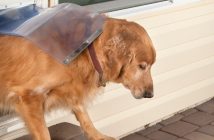by Ron Swerdfiger
When you leave the house, it is nice to know that your dog goes to one of his favorite spots or dog beds and sleeps peacefully until you return. However dogs suffering from separation anxiety are not so lucky. Separation anxiety can appear in dogs that have not been properly socialized, dogs that have been moved from one home to another and dogs that are naturally nervous.
Your dog is a social, pack animal who relies on the others (you) for individual protection and security. Dogs that lack confidence, due to socialization issues, understanding of expected behavior, or possible maltreatment in the past (adopted dogs), are more likely to exhibit behaviors related to separation anxiety.
Essentially, when you leave to go to work, or even just to the corner store for five minutes, you dog becomes upset, stressed and confused. Dogs with separation anxiety can do everything from whining and barking, to ripping apart your couch and eating your duck feathered pillow.
How do I know if my dog has Separation Anxiety?
There is much debate over the cause of separation anxiety. some believe it is a lack of confidence that causes the dog to rely to much on their humans. In this case, you have to teach your dog to accept the fact that you are leaving, and it’s going to be ok.
If you have a dog with separation anxiety, you will know. Dogs will usually exhibit a combination of the following:
– The behavior often occurs when the dog is left alone.
– The dog makes a Abig deal@ when his owner leaves, or comes home.
– Well left alone the dog will exhibit behavior which is not common to his normal behavior.
– The dog may not eat if the owner is not in the room
– The dog will follow his owner around constantly
What ever the cause is, here are some techniques for solving the problem. What can be done?
Make your Departure and Arrival Routine
Make your dog realize that your departures and arrivals are nothing to get excited over. Usually the dog feels the greatest amount of anxiety shortly after you leave. Therefore you need to practice with your dog the routine of coming and going.
Lots of Exercise!
Exercise is believed to relieve stress in both humans and dogs alike. A long walk, run, or play session with dog toys prior to leaving can go a long way in helping to reduce the stress and anxiety of your dog.
Give Your Dog Something to Do While You Are gone.
If your dog has something entertaining to do while you are away, he will be less likely to become stressed and anxious. A stuffed Kong filled with a tasty treat is an excellent example.
Confine Your Dog While You Are Away
Some dogs are more comfortable being confined to their own Aden.@ A crate is an ideal space for your dog. A dog who is properly crate trained is less susceptible to get in to trouble while you are gone. If a crate is not an option, confine him to one room or limit access to the whole house.
Introduce Another Dog
If your dog has another companion to keep him company while you=re gone, it may help alleviate the boredom and tension caused while you are away. Of course this is only ?one? option. There are many other factors to take into consideration before adding another dog to your home.
Set Aside Time For Dog
Make time during your day to give undivided attention to your dog. This time can be spent playing, teaching, or even just taking a nap together. If possible, try to make this one-on-one time prior to departures.
Leave the Radio or TV On
Leave a radio on in a separate room. The dog will hear the voice and will feel less alone. Some people even leave voice recordings of themselves in hopes to calm the dog.
Depending on the severity of anxiety, you may need to contact a behavior specialist through your vet.



